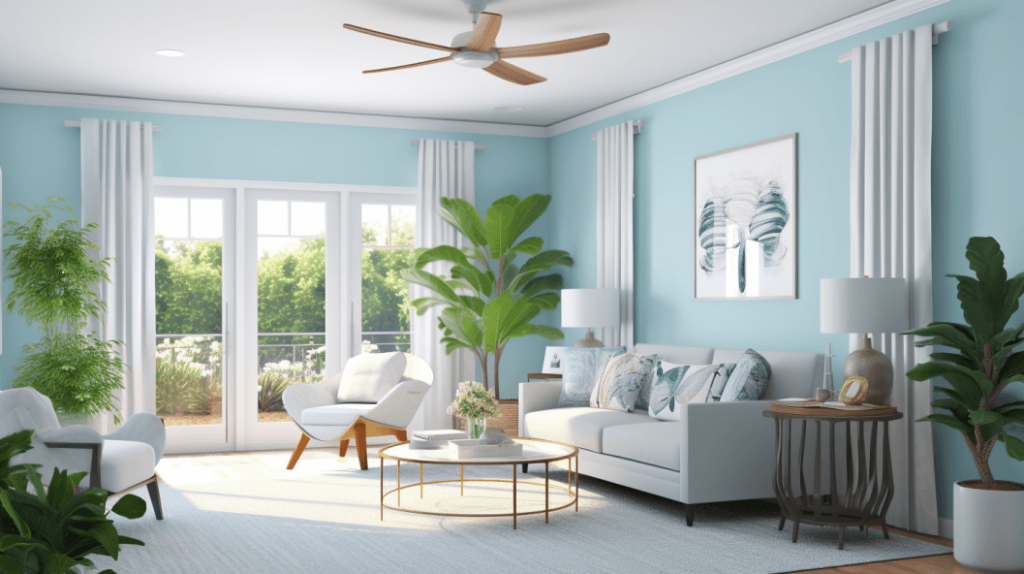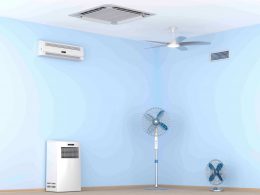of your own room. Whether it’s the sweltering heat of summer days or simply a room that always seems to trap heat, there are numerous solutions to help you achieve a more comfortable temperature. You might be thinking, why can’t I just crank up the AC and be done with it? The answer is, you could, but there are more eco-friendly, budget-friendly, and creative ways to make your room cooler.
In this comprehensive guide, we will delve into a wide range of strategies that will help you cool down your space. From understanding the basics of room cooling, and discussing the effects of room temperature on sleep quality, health, and productivity, to exploring natural cooling methods and technological solutions, we’ve got it all covered.
But why stop there? We’ll also provide easy and exciting DIY solutions that won’t just cool your room but also offer a fun project you can take on.
So, buckle up, dear readers, and prepare to transform your hot, stifling room into a cool and cozy haven. Let’s begin this journey toward a more comfortable living space together!
Understanding the Basics of Room Cooling
Before we delve into the actual methods for cooling your room, let’s make sure we understand the basic principles of cooling a space. This knowledge will aid you in making more informed choices about the cooling methods that will work best for your specific situation.
Firstly, let’s define a few key terms:
- HVAC: This stands for Heating, Ventilation, and Air Conditioning. It’s a system used in buildings (including your home) to regulate the environmental conditions, maintaining temperature and humidity at comfortable levels and ensuring adequate ventilation.
- BTU (British Thermal Unit): This is the standard measure of heat energy in the scientific world. In the context of air conditioning, it refers to the amount of heat required to raise the temperature of one pound of water by one degree Fahrenheit. In simple terms, the higher the BTU rating of an air conditioner, the more powerful it is.
- Thermostat: This is a device that regulates the temperature of a system (like an HVAC system) by switching heating or cooling devices on or off as needed to maintain the desired temperature.
Next, let’s examine some basic factors affecting room temperature:
- Sunlight: The position of your room in relation to the sun can significantly affect its temperature. Rooms that receive direct sunlight for a substantial part of the day are generally hotter than rooms that are more shaded.
- Room Size and Layout: Larger rooms are harder to cool than smaller ones because they contain more air. The layout also matters: an open-plan space may be easier to cool than a room with lots of nooks and crannies.
- Insulation: Insulation is crucial in maintaining room temperature. Good insulation can help keep your room cool in summer by preventing the cool air from escaping and blocking the heat from outside.
- Ventilation: A well-ventilated room can be much cooler than a poorly ventilated one because fresh air can circulate freely, taking away heat.
- Number of Electronic Devices: Electronics generate heat when in use. The more electronic devices you have in a room, especially larger ones like TVs or computers, the hotter the room is likely to get.
In the next sections, we will use this foundational knowledge to explore different strategies for cooling your room. Whether you’re relying on technology, embracing natural methods, or trying out some fun DIY solutions, a cooler room is well within your reach!
Importance of Room Temperature
Now that we’ve laid down the basics of room cooling, let’s turn our attention to the why – why should we strive for an optimal room temperature? From impacting your sleep quality to affecting your overall health and productivity, the room’s temperature plays a surprisingly significant role in your daily life.
Effects on Sleep Quality
You may not be aware, but the temperature of your bedroom can considerably influence your sleep quality. Your body’s core temperature naturally decreases as you prepare for sleep, and a cooler room can facilitate this process. According to sleep experts, the ideal temperature for optimal sleep is around 60 to 67 degrees Fahrenheit (or 15 to 19 degrees Celsius). If the room is too hot, it can hinder this natural cooling process, leading to discomfort and restlessness.
Impact on Productivity
The temperature of your room doesn’t just affect your thermal comfort significantly affects the mood, performance, productivity, and job satisfaction. High room temperatures cause employees to feel fatigued, whereas lower temperatures impede concentration. The studies they cite reveal a 4% decrease in productivity in colder environments and a more pronounced 10% decrease in warmer environments.
Further substantiating these results are research from the Technical University of Helsinki and the Lawrence Berkeley National Laboratory. They found that the peak productivity of employees is achieved at 21-22°C, with each rise of 1°C leading to a 2% drop in productivity. Therefore, keeping your room at a comfortable temperature can significantly enhance your productivity levels.
Health Implications
Last but not least, maintaining a cool room temperature, particularly during hot weather, is crucial for your health. Overexposure to heat can lead to heat exhaustion or even heat stroke, which can be dangerous. Symptoms include dizziness, headache, and fatigue. For those with existing health conditions, the impact can be even more severe. Ensuring your room stays cool can help prevent these health risks.
Understanding the importance of room temperature gives us more reason to ensure we’re taking steps to make our rooms cooler and more comfortable. In the next section, we’ll begin exploring various strategies you can use to achieve this goal.
Strategies to Make Your Room Cooler
Now that we understand the importance of maintaining a cool room, let’s dive into the practical solutions. There are numerous strategies that you can adopt, and we have categorized them into natural cooling methods and technological solutions. You can pick and choose based on your preferences, budget, and the specific conditions of your room.
Natural Cooling Methods
- Cross Ventilation: This technique involves aligning windows and doors in a way that allows the natural breeze to flow freely through your room. It’s a simple but effective way to lower your room temperature.
- Use of Curtains, Blinds, and Shades: By blocking the direct sunlight from entering your room, you can significantly reduce the heat inside. Blackout curtains or thermal blinds can be particularly effective, as they are designed to insulate your windows and prevent heat gain.
- Planting Trees or Installing Awnings: By providing shade for your room, trees or awnings can significantly decrease the amount of heat your room absorbs from the sun. As a bonus, trees can also improve the overall aesthetic of your surroundings.
Technological Solutions
- Air Conditioning Systems: The most obvious and effective way to cool your room is by using an air conditioner. However, it’s important to choose the right size of air conditioner for your room – one that’s too small won’t cool your room effectively, and one that’s too large will cool the room too quickly without properly dehumidifying it.
- Fans: Fans can be a cheaper and more energy-efficient alternative to air conditioners. They work by circulating air in your room, creating a draft that helps evaporate sweat and cool your body. Ceiling fans, tower fans, or desk fans can all be effective, depending on the size and layout of your room.
- Dehumidifiers: Dehumidifiers reduce the amount of humidity in the air. By doing so, they can make your room feel cooler and more comfortable, especially in humid climates.
- Evaporative Coolers: Also known as swamp coolers, these devices cool the air by evaporating water. They work best in dry climates and are more energy-efficient than traditional air conditioners.
Remember, what works best for one person might not work for another, and it might take a little bit of trial and error to find the best solution for your room. In the next section, we’ll discuss some energy-efficient solutions to further help you in your quest for a cooler room.
Energy Efficient Solutions
While natural cooling methods and technological solutions can effectively lower your room temperature, we must also consider their energy usage. After all, eco-friendly options are not only good for the environment but also kind to your utility bill. Here are some energy-efficient solutions to consider:
- Energy Star-Rated Appliances: Appliances with the Energy Star rating meet strict criteria set by the U.S. Environmental Protection Agency and the Department of Energy. If you’re considering buying an air conditioner or a dehumidifier, look for models with this rating. They’re designed to consume less energy, which is good for both the environment and your wallet.
- Smart Thermostats: A smart thermostat can significantly reduce your energy usage. These devices allow you to program your air conditioning system to run less while you’re out and start cooling your room just before you return. Some models can even learn your schedule and preferences over time, further optimizing their operation.
- Solar Screens or Window Films: Installing solar screens or window films on your windows can block out a substantial amount of solar heat, reducing the need for air conditioning. These products work by reflecting or absorbing the sun’s rays, preventing your room from heating up during the day.
Along with these energy-efficient solutions, there are also many simple changes you can make to help cool your room. Even small actions like turning off unnecessary lights and unplugging unused electronics can have a noticeable impact on your room temperature. So, before you rush out to buy a new cooling device, consider if there are any energy-saving habits you can adopt.
In the next section, we’ll explore some easy DIY solutions for those who like to take a hands-on approach. Not only are these ideas fun to try out, but they can also save you some money.
Easy DIY Solutions
For those of you who enjoy a good DIY project or simply want to cool your room on a budget, this section is for you. Here are some fun and creative solutions to make your room cooler:
- Use Cooling Mats or Pillows: Cooling mats or pillows use special gel or technology that absorbs body heat, providing a cool surface for you to lay on or rest your head. They’re typically used for beds, but you could use them for your seats or anywhere else you’d like.
- Homemade Air Conditioner: Believe it or not, you can make a simple air conditioner at home with just a fan and some frozen water bottles. Place a frozen water bottle in front of a running fan. As the ice melts, the fan will blow the cool air around the room.
- Freeze a Bed Sheet: This may sound strange, but it works. Dampen a sheet, wring it out, and then freeze it for a couple of hours before bedtime. The cool sheet can help lower your body temperature, especially in the heat of summer nights.
- Ice Water Bowl in Front of a Fan: Similar to the frozen water bottle trick, you can also place a bowl of ice or ice-cold water in front of a fan. As the ice melts, the fan will blow the cool air around your room.
- DIY Reflective Window Panels: If you can’t afford solar screens or window films, consider making your own reflective window panels using cardboard and aluminum foil. The aluminum foil will reflect sunlight away from your room, reducing the amount of heat that enters.
These DIY solutions aren’t just effective at cooling your room; they also offer a fun and satisfying project to undertake. In the next section, we’ll discuss some tips for designing your room to naturally stay cooler. These tips can be particularly useful if you’re renovating or moving into a new place.
Room Design Tips for a Cooler Room

Design can play a significant role in your room’s temperature, so let’s consider some design tips that can help keep your room naturally cooler:
- Choice of Colors: Light colors reflect heat, while dark colors absorb it. Painting your room a light color, particularly white or pastel shades, can help keep it cooler. This principle applies to your curtains and furniture as well.
- Proper Insulation: Good insulation isn’t just for keeping your home warm in the winter. It can also help keep your home cool in the summer by preventing the cool air inside from escaping and the heat outside from entering. Consider insulating your walls, roof, and floors.
- Window Placement and Treatment: Windows can let in a lot of heat, especially if they face the sun for many hours a day. If you’re designing a new room or renovating, consider placing windows on the north or south sides of your room to avoid direct sunlight. For existing windows, consider treatments like solar screens, window films, or thermal curtains to reduce heat gain.
- Choosing Cooling-Friendly Furniture: Some materials can retain heat, making your room warmer. Opt for furniture made from materials that stay cool, such as cotton, linen, and rattan.
- Optimizing Airflow: Ensure there is enough space for air to flow freely in your room. Avoid placing large furniture pieces in front of windows or vents, which can obstruct airflow.
- Green Roofing: If you’re up for a more significant project, consider installing a green or “living” roof. These roofs have vegetation growing on them, which provides natural insulation and helps to reduce the temperature of your room.
These design tips can go a long way in creating a cooler room without needing to rely too heavily on air conditioning or other cooling devices. In the next section, we’ll emphasize the importance of regular maintenance and care for these cooling methods and devices to function optimally over time.
Regular Maintenance for Optimal Cooling
After implementing some (or all) of the cooling strategies outlined above, it’s crucial to remember that regular maintenance is a key part of ensuring these methods continue to work effectively. Here’s how to keep your cooling systems in top condition:
- Air Conditioning Systems: Regularly clean or replace your AC filters as per the manufacturer’s instructions. A dirty filter reduces your AC’s efficiency and can lead to higher energy consumption. Also, schedule regular maintenance checks with a professional to ensure the system is working correctly.
- Fans: Dust your fans regularly. Dust build-up can make the fan work harder and reduce its effectiveness. Ensure the blades are clean, and check the motor from time to time.
- Dehumidifiers: Empty the water tank regularly and clean the air filter as instructed in the device manual. A dirty filter or full water tank can cause the dehumidifier to work less efficiently.
- Window Treatments: Clean your curtains, blinds, and shades regularly. Dust and dirt can reduce their reflective properties and thereby their effectiveness at blocking out heat.
- Room Layout: Keep the areas around your vents and windows clear. Furniture, curtains, or other items blocking these can prevent the free flow of air and natural light.
- DIY Solutions: These will likely need the most regular upkeep. For example, you’ll need to refreeze your water bottles or ice packs daily, and you’ll need to create new reflective window panels if the old ones become damaged.
Consistent maintenance will ensure your room stays cool and comfortable, and it can also extend the lifespan of your cooling devices. It’s a small price to pay for a consistently cool and refreshing room.
In our final section, we’ll provide a quick and handy checklist summarizing all the tips and solutions discussed so far, giving you a one-stop guide to refer back to as you embark on your room cooling journey.
A Quick Recap: Your Room Cooling Checklist
We’ve covered a lot of ground in this post, so let’s conclude with a handy checklist summarizing all the strategies we’ve discussed for making your room cooler. Use this as a quick reference guide as you put these tips into action:
Understanding Room Cooling Basics
- Get to know the role of HVAC systems, BTUs, and thermostats in room cooling
- Understand the factors influencing room temperature: sunlight, room size and layout, insulation, ventilation, and electronics
Natural Cooling Methods
- Optimize cross ventilation by properly aligning windows and doors
- Use curtains, blinds, or shades to block direct sunlight
- Plant trees or install awnings for external shade
Technological Solutions
- Install an appropriate air conditioning system
- Utilize different types of fans
- Consider a dehumidifier or an evaporative cooler
Energy-Efficient Solutions
- Choose Energy Star-rated appliances
- Install a smart thermostat
- Use solar screens or window films
DIY Solutions
- Try out cooling mats or pillows
- Experiment with homemade air conditioners
- Freeze a bed sheet or place a bowl of ice in front of a fan
- Make DIY reflective window panels
Room Design Tips
- Paint your room in light colors
- Insulate your room properly
- Position windows strategically or add protective window treatments
- Opt for cooling-friendly furniture
- Arrange your room to optimize airflow
- Consider green roofing if possible
Regular Maintenance
- Clean or replace air conditioning filters regularly
- Dust your fans and check the motors periodically
- Empty and clean your dehumidifier regularly
- Clean your window treatments often
- Keep areas around vents and windows clear
- Regularly upkeep your DIY solutions
With all these strategies and tips in your arsenal, you’re now well-equipped to make your room cooler, no matter what the weather outside is like. Happy cooling!
Conclusion: Enjoying a Cooler and More Comfortable Room
After our in-depth discussion on ways to make your room cooler, we hope you have gained valuable insights and practical solutions to apply to your space. Whether it’s your bedroom, office, or any other room, maintaining a cool and comfortable environment can significantly improve your sleep quality, productivity, and overall health.
Remember that the best approach depends on your unique circumstances – the size and orientation of your room, the climate you live in, your budget, and personal preferences. Feel free to mix and match the solutions we’ve discussed to find what works best for you.
Lastly, it’s worth noting that making your room cooler doesn’t have to involve significant expense or effort. Even small changes, such as adjusting your room layout, choosing the right window treatments, or regularly maintaining your cooling devices can have a big impact. And with our easy DIY solutions, you can even turn this into a fun and satisfying project.
As you implement these strategies and start to enjoy a cooler room, you’ll wonder how you ever managed in a hot and stuffy room. Here’s to a cooler, more comfortable living space and all the benefits it brings!
Thank you for taking the time to read this blog post. If you have any questions or if there’s anything else you would like to learn about, don’t hesitate to get in touch. Stay cool!
Frequently Asked Questions (FAQs)
To wrap up this blog post, let’s go through some common questions people often ask about making their rooms cooler.
Q1: Why is my room so hot compared to the rest of the house?
A: There could be several reasons for this. It might be due to poor insulation, a lack of ventilation, or the position of your room (e.g. if it faces the sun for most of the day). Electronic devices and lights can also heat up a room significantly. Examine these factors to identify what might be causing your room to be warmer.
Q2: Can plants really help cool a room?
A: Yes, plants can help cool a room by releasing moisture into the air through a process known as transpiration. However, you’d need a significant number of plants in your room to notice a substantial difference in temperature.
Q3: Is it better to use an air conditioner or a fan to cool a room?
A: Both have their pros and cons. Air conditioners are more effective at cooling a room, but they also consume more energy and can lead to drier air. Fans are less effective but use less energy and can help maintain a comfortable level of humidity. If possible, using a combination of both can be an optimal solution.
Q4: Do blackout curtains really help keep a room cool?
A: Yes, blackout curtains can be quite effective at keeping a room cool. They block sunlight, reducing the amount of heat that enters your room.
Q5: Is there a particular color I should paint my room to keep it cool?
A: Light colors, particularly white, can reflect heat away from your room, making it cooler. Dark colors, on the other hand, absorb heat. So if you’re trying to keep your room cool, it’s better to choose light colors for your walls.
Q6: How can I keep my room cool without an air conditioner?
A: There are numerous ways to cool a room without an air conditioner. These include optimizing ventilation, using curtains or blinds to block sunlight, using fans, planting trees, or installing awnings, and using DIY solutions like a homemade air conditioner or reflective window panels.
Remember, if you have any other questions or need more specific advice, don’t hesitate to get in touch. We’re always here to help you achieve a cooler and more comfortable room.










